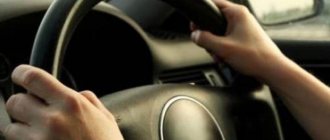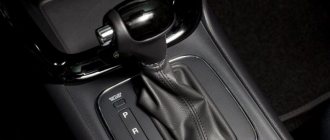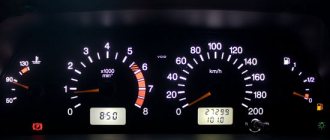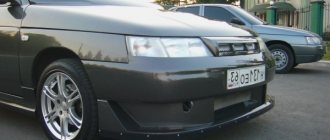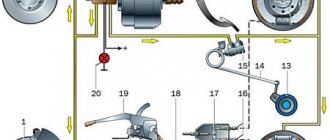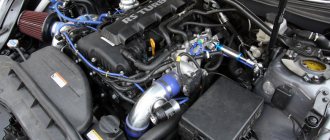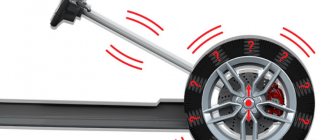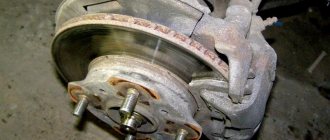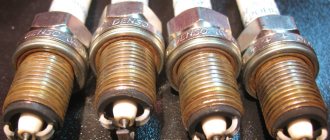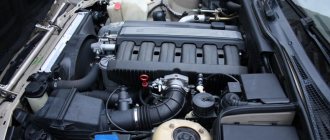Any driver is very alarmed by situations when vibration appears at a speed of 100-120 km/h on the steering wheel or along the body. And the point here is not only about discomfort, although it must be said that these symptoms are a rather unpleasant phenomenon. If measures are not taken to correct the problem in time, this may lead to a violation of the geometry of the body. This will not happen immediately, but slowly and gradually.
Distortions can provoke a violation of the aerodynamic characteristics, as well as deterioration of the vehicle's handling. In addition, due to vibration effects, cracks can form in the metal, which is not only dangerous in itself, but also requires expensive repairs.
And that's not the whole problem. If the car vibrates at a speed of 100-120 (VAZ 2110 is no exception), this leads to the loosening of various fasteners. This phenomenon can lead to serious consequences - accidents, as well as various malfunctions and damages, which will be very difficult to eliminate. It is worth adding that this kind of shaking is a signal of breakdowns that will yet occur in the near future.
Vibration at speeds of 100-120 km/h occurs for various reasons. These may be completely harmless problems. But sometimes there are serious cases that require global intervention in the technical structure of the car. Further in the article we will look at the typical reasons why vibration is transmitted to the steering wheel and car body at high speeds.
Causes of steering wheel vibration when driving
Everyone should know why the steering wheel wobbles when driving in order to correctly solve this problem:
- Wheel imbalance due to large amounts of dirt or stuck snow;
- Steering wheel vibration at speeds of 100, 120 km/h when the wheels are unbalanced;
- Poor quality discs (defective);
- Insufficiently inflated wheels;
- Poor quality wheel fastening;
- Problems with the suspension;
- Beating at idle;
- Vibration in the steering wheel when braking.
Symptoms of imbalance and diagnosis
You can determine if the balance is out of balance when driving at high speeds. In this case, vibration will be felt on the steering wheel or on the body. The problem can be diagnosed using a visual inspection. Wheel rims should be as smooth as possible, without dents. If the car has not recently driven at speed through potholes, and slight vibration is felt on the steering wheel and body, then most likely the problem is imbalanced balancing.
However, you should not think that if the steering wheel shakes, then it is enough to give only two front discs for balancing. Often the only way to fix a problem is to balance all four.
Steering wheel vibration at speed due to wheel imbalance
A common cause of this problem is the accumulation of a large amount of soil or snow on the tires. This deficiency often appears for a while. As practice shows, vibration on the steering wheel disappears at a speed of 100 km/h, but may return after a few minutes. It is easy to find out the reason for the steering wheel beating at speeds of 100, 120 km/h with alloy wheels. If you have them made of steel, this will not be so easy for the driver to do, because the ventilation holes here are small. Lumps of earth often collect inside the disk and are not visible to the naked eye.
In order to use only the best consumables when caring for your car, we recommend that you familiarize yourself with the rating of motor oils.
Violation of wheel alignment geometry
Directly dependent on incorrectly set wheel geometry, vibration can occur only during acceleration or in a certain speed range. You can find out if the toe-in and camber are installed incorrectly quite quickly - make a visual inspection of the tires and see how they wear out. If they have large uneven wear, this indicates a violation of the wheel alignment angles.
If the tires are worn only on the outside, or only on the inside, then this indicates a violation of the geometry. This issue can be resolved by adjusting the installation angles. Only in this case, vibration of the steering wheel when driving 100-120 km per hour will quickly disappear.
However, it may happen that the toe and camber are adjusted, but the fault does not disappear. The installation angles are adjusted correctly. But the car owner decided not to replace the tires with new ones, since they were not too worn out yet and could be used. In this case, you should drive at low speeds so that the tires wear evenly, and the problem will disappear.
Steering wheel beating at speeds of 100, 120 km/h when the wheels are unbalanced
Everyone knows that the tires and wheels on any car, be it a VAZ 2110, VAZ 2109, Audi, Renault, Ford or any other, will not be ideal in terms of evenness and composition. In addition, the weight of the wheels in different parts is not the same and when the car starts to move, the place that has a large mass will begin to pull the center of the wheel towards itself, which will be a centrifugal force.
Lack of wheel balancing
Wheel rims are manufactured to be uneven in shape and composition, resulting in different weights being applied to each area. The center is pulled in the direction where the greatest mass is located. As soon as the center shifts, the centrifugal force also shifts. As a result, there is a beating in the steering wheel at speed due to the existing transmitted forces along the chain of rods at high speeds.
That is why it is necessary to balance the wheels after each tire or wheel change. Balancing is a process in which the mass of the wheel is equalized along the entire contour using special elements, popularly called “weights.” They are glued or hammered onto the wheel rim from the inside.
Steering wheel wobble when driving due to damaged or poor-quality discs
Both in the VAZ 2110 and other cars, steering wheel vibration at speed can occur due to the fact that the wheels are curved. Any specialist in tire fitting will notice this fact. In addition to dents, there may also be factory distortions on the wheel. If your tires have already served you for several years, they are quite old - this can negatively affect the full operation of the steering wheel. Common signs of tire deformation include:
- poor, worn condition of the cord;
- potholes in the tires due to the fact that you previously fell into holes at speed;
- poor quality production, which can manifest itself in different ways.
With “bumps” on the tires, the driver will feel both poor steering wheel function and rattling of the entire car. When you pick up speed, you will only feel the steering wheel vibrating as you move. However, when you reach 90-120 km/h, you will hear the entire car operating incorrectly.
avtoexperts.ru
Even if car enthusiasts react quite nervously to such common phenomena as the rattling of glass and plastic inside a car, vibration of the steering wheel can put almost every driver in a mental hospital - this is a very annoying and unpleasant process. Jokes aside, vibrations on the steering wheel are a very serious problem. Today we will find out the reasons for its occurrence and tell you how to cope with this disaster.
Causes of vibrations on the steering wheel
As a rule, vibrations in the steering wheel appear under various conditions: when the car is moving at different speeds, braking, or when the car is stationary and its engine is idling. If the beating of the steering wheel has become annoying, you need to determine in what circumstances it manifests itself, and depending on this, diagnose the cause.
Steering wheel wobble when the car is stationary
Vibrations in this case can occur for two reasons: due to loose engine mounts or due to problems with the steering rack drive shaft. In the first option, when the engine is idling, the steering wheel hits quite hard. Such vibrations appear on cars with high mileage: either the mountings of the power unit have become loose over time, or the engine was not installed properly after a major overhaul. If even at low speeds a significant beating of the steering wheel is felt, then as the speed increases, the vibrations increase and driving such a car becomes not only uncomfortable, but also unsafe.
The second option: the occurrence of vibrations at idle speed in a stationary car can be caused by wear of the splined part of the steering rack drive shaft or deformation of the shaft itself. With this option, the steering wheel runout may also increase when the car moves.
You cannot drive with such vibrations for a long time because it can lead to destruction of the steering mechanism elements, and, as a result, loss of control of the car - an accident.
Steering wheel vibration when driving at different speeds
Here there are more factors causing vibrations, and they are mainly related to the condition of the wheels.
Firstly, steering wheel beating can occur due to the fact that the wheel rims become clogged with snow or dirt, which leads to imbalance of the wheels and, as a result, the appearance of those same annoying vibrations. In this case, the steering wheel only shakes at low speeds, and when the speed increases, the vibrations disappear completely.
Secondly, steering wheel vibrations can occur at medium (no more than 60 km/h) and high speeds if the wheels were not properly balanced during a seasonal tire change or after tire repair.
In this case, the masses of the wheels become different; when the speed increases, the centrifugal forces of such wheels differ, which is why the steering wheel wobbles. You can’t drive with unbalanced wheels for a long time - in addition to driving discomfort, you can ruin the tires (uneven wear) or, more seriously, damage the suspension elements (in this case, the hub bearings suffer the most).
Thirdly, steering wheel beating can be caused by deformation of the wheel rims (most often steel wheels are susceptible to this). Most often, vibrations in this case occur after the car has crashed into a pothole with one or even two wheels. It happens that a deformed wheel rim is sold to you in a store or market - this is a manufacturing defect. It is not always possible to determine by eye whether crooked rims are the cause of vibrations on the steering wheel - often this bends the inner part of the rim, not the outer one.
You can diagnose this reason by removing the wheels yourself, or by contacting the nearest tire shop.
Fourthly, steering wheel vibration may occur if the holes in the wheel rim do not match the diameter of the bolts on the wheel hub. This manifests itself when non-original rims are installed on the car. In this case, the disc begins to “jump” on the hub, vibration occurs, which is transmitted to the steering wheel. The higher the speed, the more the steering wheel vibrates.
Fifthly, steering “fever” occurs due to tire defects. This includes deformation of the cord or sidewall of the tire, which can be caused by manufacturing defects or improper use of the rubber (driving on roads with potholes).
Steering wheel wobble at speeds of 100-120 km/h due to poor-quality wheel fastening
If your wheel nuts are not fastened firmly and securely enough, this is also the cause of vibration of the steering wheel and the entire car at speed. Loose nuts are one of the simplest and most easily diagnosed problems, but also the most dangerous. If you don’t pay attention to the incorrect operation of the wheels in time and while driving they fly off from your car, an accident cannot be avoided, which will end badly not only for you, but also for other people.
Repairing a car in the event of a “lost” wheel can cost a considerable amount of money if the problem is not diagnosed in time. In this case, it may be necessary to replace the brake disc, hub or other components. To be confident in your car, it is better to securely secure the nuts and bolts on the wheels or entrust the matter to professionals for maintenance.
Don’t forget about other important parts of the car; in particular, we recommend that you read the article on checking the battery charge.
Engine mounts, tie rods and other problems
There is another group of problems that cause vibrations when accelerating a car. It is difficult to collect these problems into one bundle, because they are all different and arise for various reasons. Vibration often occurs when one of the engine mounts is broken. This can easily be checked by increasing the speed while shaking.
The gearbox may also be the culprit for this type of problem. If the car starts to shake at 80 kilometers per hour, you can very easily check the fault of the gearbox by performing the following procedures:
- accelerate to a speed of about 85 kilometers per hour;
- depress the clutch and observe the vibration change;
- engage third gear and smoothly release the clutch;
- try accelerating from 50-55 kilometers per hour in last gear.
How suspension malfunctions can cause steering wheel vibration when driving
If the suspension is worn out, its functioning will affect the full operation of the car and its contact with the road. When play appears, the same imbalance will arise when the steering wheel is rotated as when the car’s tires are insufficiently inflated. However, backlash cannot indirectly cause this problem; it will only act as a catalyst.
Information letter No. 5-17 dated 01/23/17
When owners of LADA cars of the KALINA, GRANTA, PRIORA, VESTA families, equipped with a 1.6 liter engine and gearboxes 2180/2181/2182, complained about “Vibrations, jerking when starting the car”
Carry out diagnostics according to the attached methodology, Appendix 1.
If you need to replace the clutch kit:
- If the vehicle is equipped with a driven clutch disc 21703-1601130-30
, in the absence of violation of operating rules, replace the clutch kit under warranty with: pressure plate
21703-1601085-30
, driven disc
21703-1601130-31
; - If the vehicle is equipped with a driven clutch disc 21703-1601130-31
(standard installed only on LADA VESTA GFL120 (KP 21827) vehicles) or a driven clutch disc
21703-1601130-32
(standard installed only on LADA VESTA vehicles GFL110 (KP 21807)) it is necessary to draw up a CLO with a description of the work performed and act in accordance with the recommendations received in response to the CLO.
Fill out the AGO for the work performed with a description of the reasons for the non-compliance and using the defect code, 1601130-051-001 “Vibration, jerking when starting a car with AMT”
, with attachment of a photo of error codes or 0
“Vehicle vibration when starting off”
, depending on the vehicle configuration, defective part 1601130, labor intensity item in accordance with the current collection of labor intensity.
Steering wheel wobble at low speed and at idle
Also, difficulty with the occurrence of steering wheel vibration when turning right or left can be caused by insufficiently reliable fastening of the internal combustion engine to the car body. This leads to consequences such as:
- large feedback from the steering wheel at idle;
- vibration of the steering wheel when the car comes to a complete stop;
- deviations in the steering when starting the car;
- when squeezing the accelerator and increasing speed.
It is very simple to recognize the cause of such vibration in the steering wheel: a high-frequency beat occurs, the vibration completely depends on the number of engine revolutions. Consequently, as the speed increases using the gas pedal, the vibration becomes more frequent. The problem can also arise if the drive shaft is not operating correctly. However, this rarely happens.
Discs
The most common cause of steering wheel wobble on the “ten” and all VAZ cars is brake discs. They may even be new, but from the factory have deviations in geometry, hence the problems. It is almost impossible to check this visually when purchasing; you need to either look for branded spare parts, or try different batches, try to find disks from older cars.
If the brake discs are crooked, it can hit not only the steering wheel, but also the brake pedal. But with severe wear, vibration usually goes mainly to the steering wheel. Naturally, when replacing discs, you should immediately change the pads and check the calipers; there should be no play or varying degrees of fit.
In principle, approximately 85% of runout cases occur in the discs and brake mechanism. It’s also worth checking all the caliper fastening units, maybe a bolt has been cut off somewhere or has become unscrewed.
Vibration in steering wheel when braking at speed
Pay attention at what point the steering wheel starts to wobble. If this process begins while the car is braking, then there is a high probability that the problem is hidden in the brake drums or discs. This indicates that the parts are deformed and their working surface has become uneven.
Components of a vehicle's brake system may be deformed for the following reasons:
- due to too long work and excessive wear;
- when overheating, when the driver presses the brake pedal too hard;
- cooling.
Taking into account these problems, the brake discs turn into wavy ones, and the shape of the drums changes from round to oval. However, the latter are more difficult to deform using the above methods. When deformation of parts occurs, vibration is felt by the driver only during light or hard braking, at a time when the pads begin to perform their task. As a result of this process, the entire braking system of the machine is exposed to vibration.
You can get rid of the problem only by purchasing new discs or drums for your car. To avoid vibration of the steering wheel at speed or when braking, carry out a routine technical inspection of the car and listen to the operation of the “steering wheel” while the car is moving.
Lada Granta › Logbook › Getting rid of engine vibration part 2. Inspection of the throttle
1 Cleaning and lubricating the throttle
Lately the car has become very annoying with the throttle behavior. The car reacted nervously and with a slight delay to pedal presses, the idle speed fluctuated greatly, and releasing the gas was like a blow. I went for spring diagnostics for 299 rubles. Everything is fine, no electrical problems. I checked the spark plugs and changed the fuel. There was no effect, I tried to remove and clean the throttle, but knowing AvtoVAZ I decided to look at the condition of the E gas reducer. I bought a throttle cleaner and got to work. When I unscrewed the throttle nuts, the studs came out with them. The studs are held inside the plastic manifold by nuts; they fell out. I had to look for new ones and use thread glue. The damper was crap quite badly, especially around the axis of rotation. I slightly lifted the flap and turned it; it moved with little effort and stuck. A view opened up to the end of the damper; there was a lot of carbon deposits on it, which interfered with the passage of air at idle. Hence the sausages at low speeds. I washed everything, blew it with a cleaner from the heart. The biggest surprise was waiting inside the gearbox. We open it and see a completely dry gearbox. Not a drop of grease on the gears. The idler gear shaft has wear and plastic dust from the gear. And there’s actually an oval hole in the lid! I blew it out and lubricated it, very little lubrication is needed. A little inside the idler gear, a little into the cover and onto the drive gear of the engine. We close everything and put it in place. The result is excellent. Before cleaning and inspection: — Starting the engine was accompanied by vibration and floating speed. — Idle speed fluctuated greatly from 830 to 950 revolutions, sharply and with dips. — Acceleration up to 2500 rpm was sluggish, after 2500 it was like a kick. The car accelerated faster. — The release of gas was accompanied by a strong nod, which created discomfort in the flow. — The overall reaction to the gas pedal was very sluggish. — Squeaking sound when the ignition is turned on. After cleaning and inspection: - Now the engine starts, somehow abruptly, the speed is stable, vibrations are minimal - Idle speed has become more even, floating within 860 - 900 revolutions. — Acceleration is now smooth throughout. There is no such jerk after 2500. — The throttle release is smooth, the needle falls smoothly
Wheel alignment and tire quality are another reason for shaking
If the wheel alignment angle is incorrect, vibration, the car pulling to the side, uneven eating of rubber and other unpleasant manifestations are possible. In different models, these problems manifest themselves in different aspects. Adjusting the wheel alignment angles is one of the first processes that needs to be performed after detecting such a nuisance as body vibration.
Problems can also be caused by tires that are worn incorrectly, or a disc after a serious impact. The main processes that can be taken to eliminate body vibration in this case are as follows:
- adjusting the wheel alignment angle at a wheel alignment station;
- replacing tires if there are visual indicators of uneven or excessive wear;
- replacing or repairing a disc that shows dents and uneven rims;
- performing wheel balancing - often during operation the balancing weights fly off.
If the balancing weights have come off the wheel, this may well cause vibrations at speeds of 80 kilometers per hour. The problem is that it is simply impossible to determine this yourself and find out which wheel needs to be sent for balancing. Therefore, you will have to go to a tire shop and have all the wheels of your car balanced.
This is one of the most inexpensive and safest options for breakdowns due to vibration of the body or steering wheel during acceleration. Therefore, the first thing you need to do is check for the presence of such faults, and then transfer suspicions to other options.
